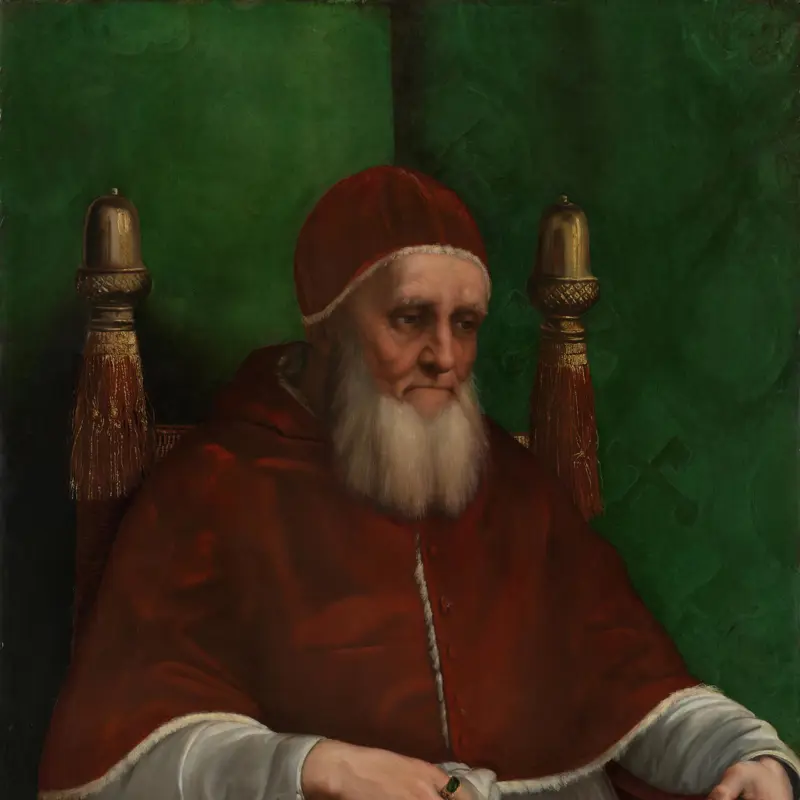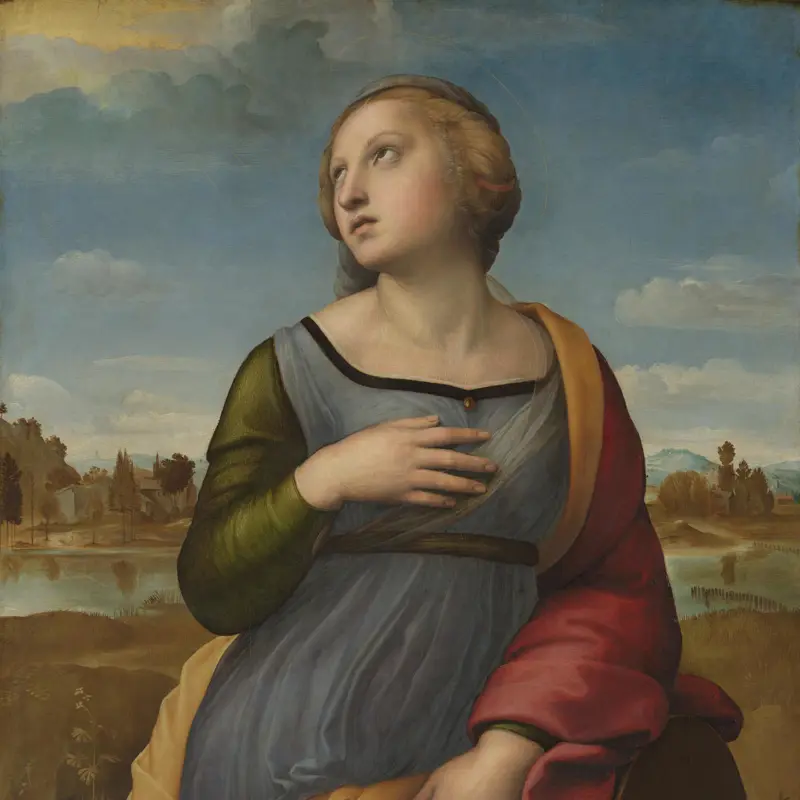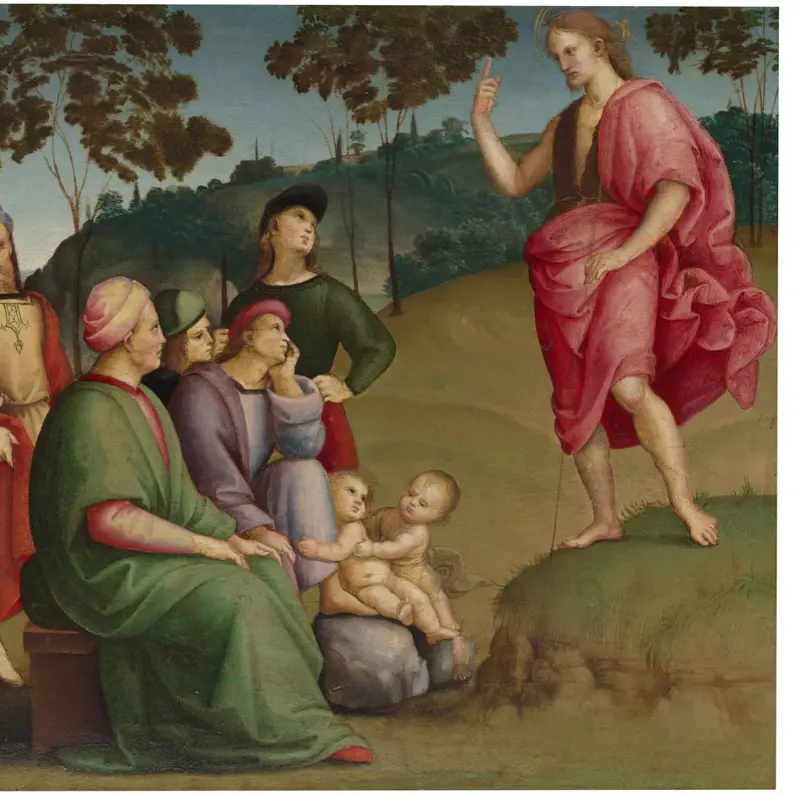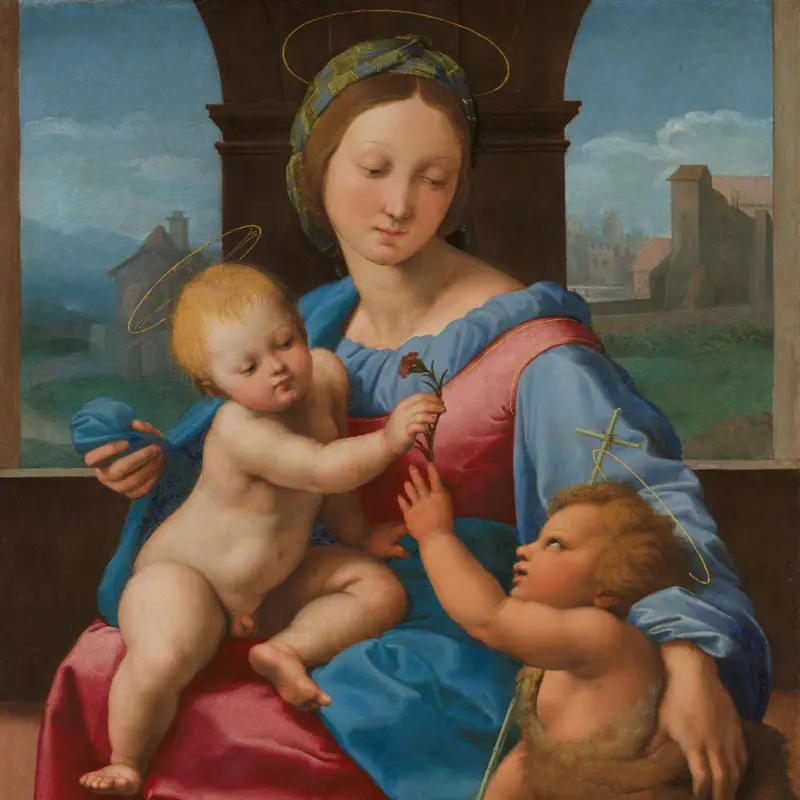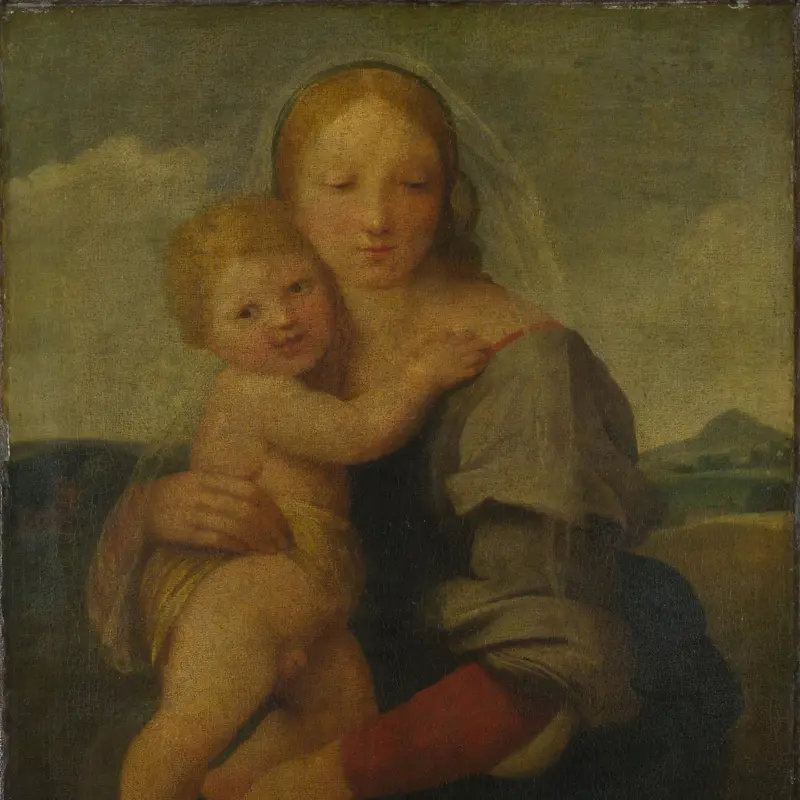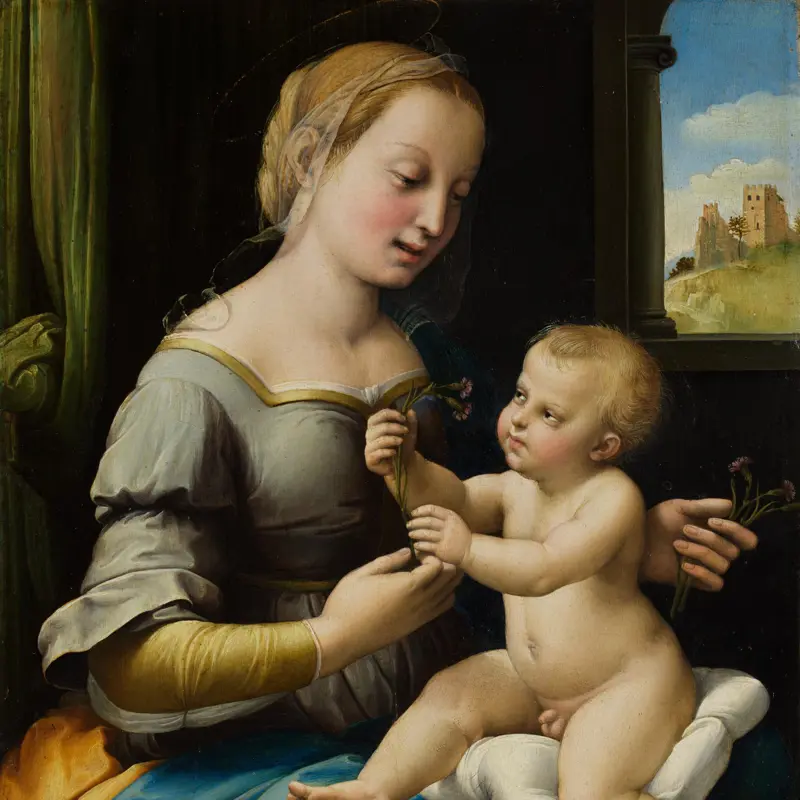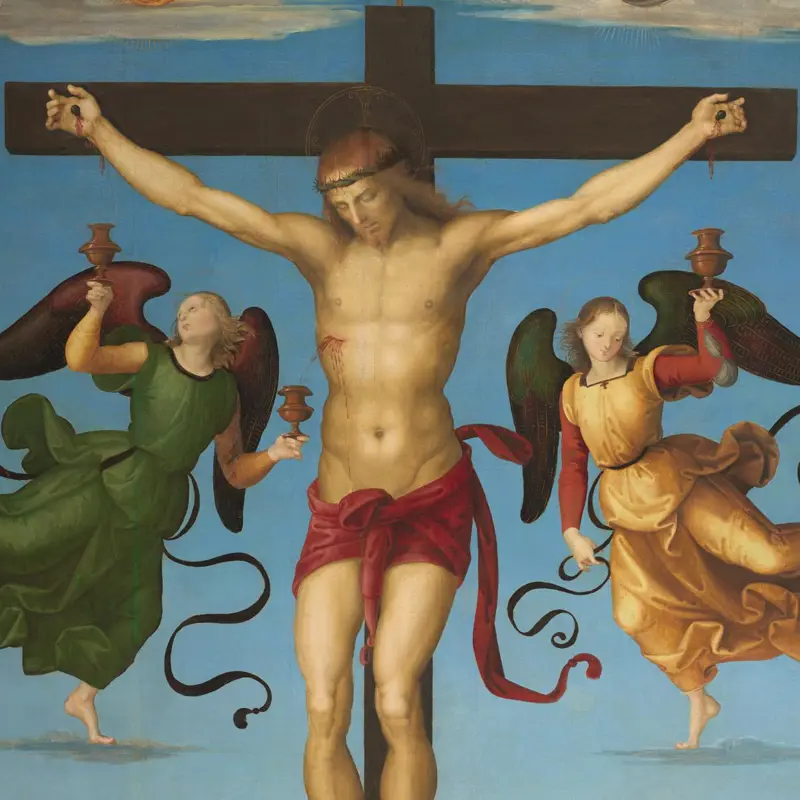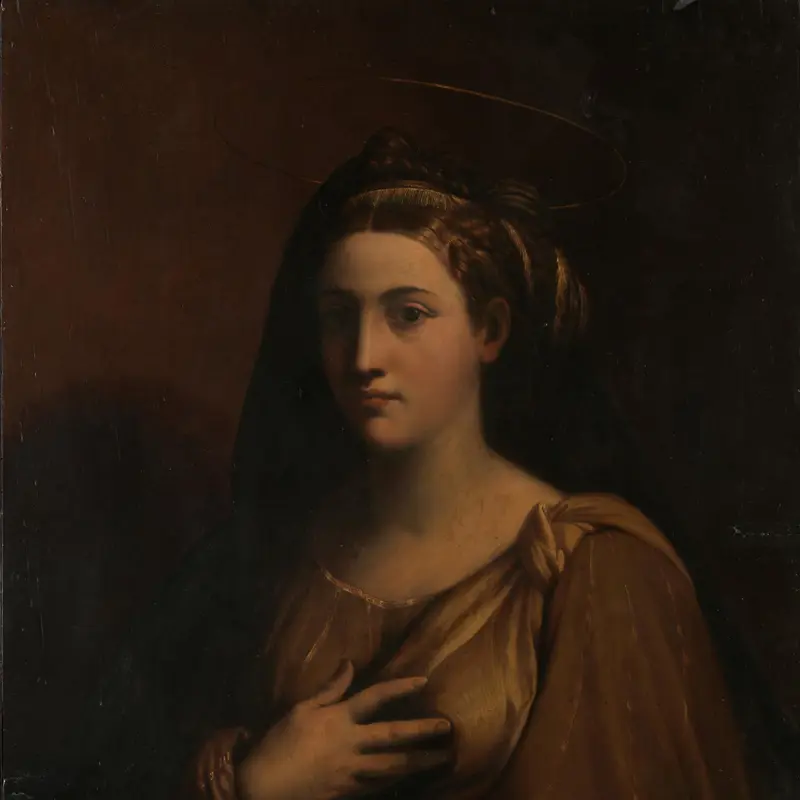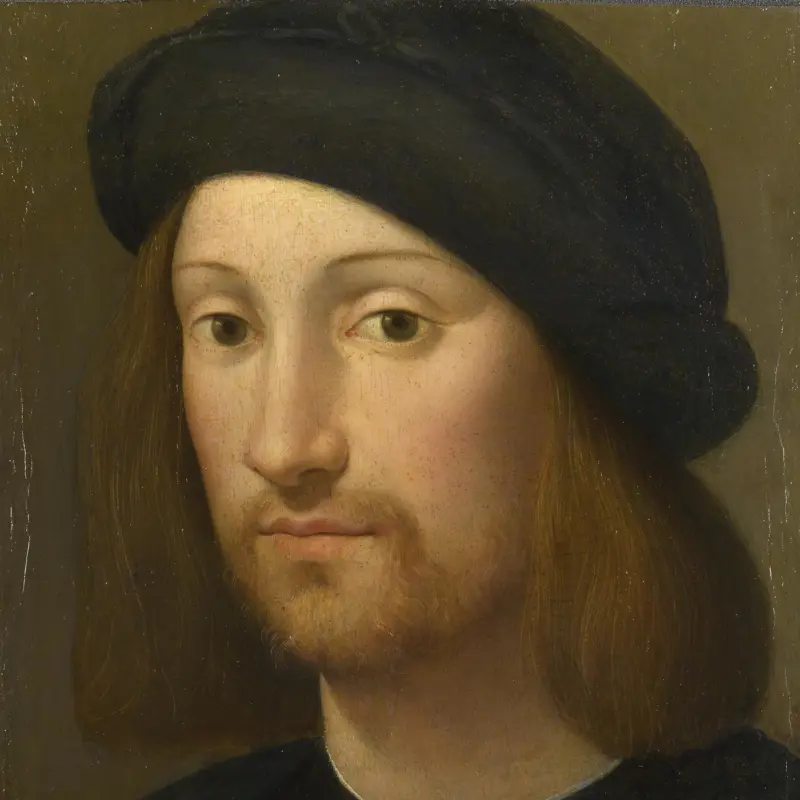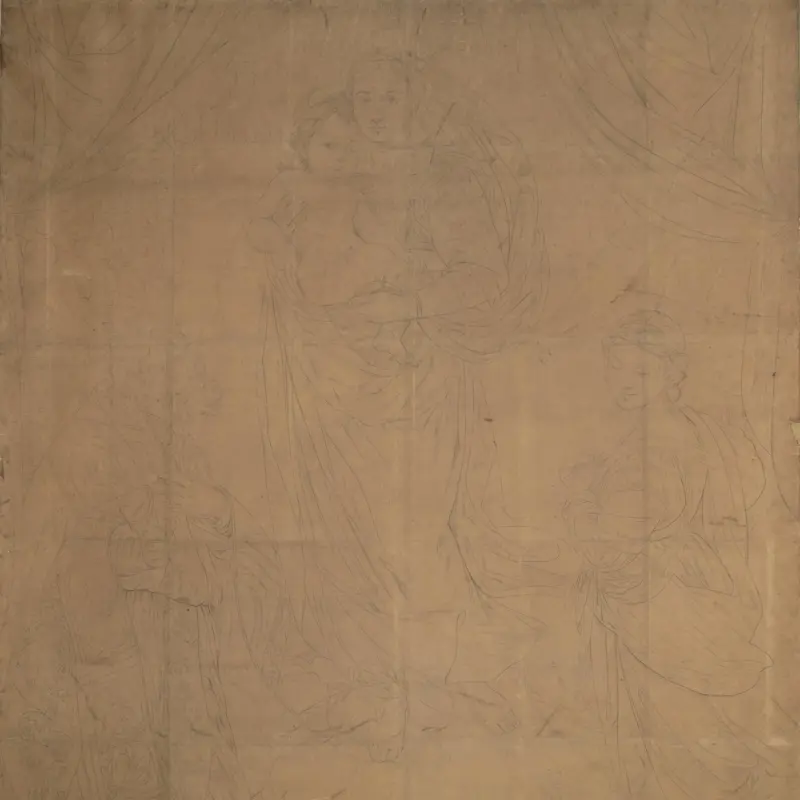Raphael, 'The Dream of a Knight', about 1504
About the work
Overview
While resting in the shade of a bay tree, the young soldier Scipio has a vision of Virtue and her adversary Pleasure. Virtue promises Scipio honour, fame and glory through victory in war. Pleasure, with fragrant flowing hair, promises a life of ease and serenity.
Raphael interpreted the theme not as a moral dilemma but as a combination of all the virtues to which an ideal soldier should aspire. An Allegory is first recorded in the Borghese collection in Rome in the seventeenth century with Raphael’s The Three Graces (Musée Condé, Chantilly), which is identical in size and style. The combination of the traditionally masculine virtues of courage, learning and love with the traditionally feminine virtues of chastity, beauty and love suggest that the two little paintings may have been made to mark the occasion of a marriage.
Key facts
Details
Provenance
Additional information
Text extracted from the ‘Provenance’ section of the catalogue entry in Carol Plazzotta and Tom Henry, ‘National Gallery Catalogues: The Sixteenth Century Italian Paintings’, vol. 4, ‘Raphael’, London 2022; for further information, see the full catalogue entry.
Exhibition history
-
2009Raffaello e UrbinoPalazzo Ducale di Urbino Galleria Nazionale delle Marche4 April 2009 - 12 July 2009
-
2013The Renaissance DreamPalazzo Pitti21 May 2013 - 15 September 2013
-
2016Painters' Paintings: From Freud to Van DyckThe National Gallery (London)23 June 2016 - 4 September 2016
-
2017Raphael and the Eloquence of DrawingAlbertina26 September 2017 - 7 January 2018
-
2020RaphaelScuderie del Quirinale5 March 2020 - 30 August 2020
-
2022The Credit Suisse Exhibition: RaphaelThe National Gallery (London)9 April 2022 - 31 July 2022
Bibliography
-
1650G. Manilli, Villa Borghese fuori di Porta Pinciana, Rome 1650
-
1787F.W.B. von Ramdohr, Über Mahlerei und Bildhauerarbeit in Rom für Liebhaber des Schönen in der Kunst, Leipzig 1787
-
1811J. Christie, A Catalogue of a Truly Capital and Highly Valuable Assemblage: Chiefly of Distinguished Italian, and a few Spanish, French, Flemish and Dutch Pictures: William Young Ottley Collection, London, 25 May 1811
-
1824W. Buchanan, Memoirs of Painting: With a Chronological History of the Importation of Pictures by the Great Masters into England Since the French Revolution, London 1824
-
1833J.D. Passavant, Kunstreise durch England und Belgien, Frankfurt am Main 1833
-
1836J.D. Passavant, Tour of a German Artist in England, London 1836
-
1839J.D. Passavant, Rafael von Urbino und sein Vater Giovanni Santi, 3 vols, Leipzig 1839
-
1878A. Springer, Raphael und Michelangelo, Leipzig 1878
-
1882J.A. Crowe and G.B. Cavalcaselle, Raphael: His Life and Works, 2 vols, London 1882
-
1897R. Maulde la Clavière, 'Le songe du chevalier', Gazette des beaux-arts, XXXIX, 1897, pp. 21-6
-
1913O. Fischel, Raphaels Zeichnungen, Berlin 1913
-
1930E. Panofsky, Hercules Am Scheidewege und Andere Antike Bildstoffe in der Neueren Kunst, Leipzig 1930
-
1936K.G. Baudissin, 'Auf der Suche nach dem Sinngehalt, I: Raffaels Junger Ritter am Scheideweg', Jahrbuch der Königlich Preussischen Kunstsammlungen, LVII, 1936, pp. 88-97
-
1948O. Fischel, Raphael, trans. B. Rackham, London 1948
-
1962Gould, Cecil, National Gallery Catalogues: The Sixteenth Century Italian Schools (excluding the Venetian), London 1962
-
1967E. Wind, Pagan Mysteries in the Renaissance, London 1967
-
1971L. Düssler, Raphael: A Critical Catalogue of His Pictures, Wall-Paintings and Tapestries, trans. S. Cruft, London 1971
-
1972K.W. Forster, 'Review: John Wyndham Pope-Hennessy, "Raphael", 1970', Art Quarterly, XXV, 1972, pp. 425-6
-
1973M.E. van Lohuizen-Mulder, Raphael's Encomium of Scipio Africanus the Elder. A Painted Mirror of Princes for the Young Scipione Borghese, Utrecht 1973
-
1975C. Gould, Delaroche and Gautier: Gautier's Views on the 'Execution of Lady Jane Grey' and on other Compositions by Delaroche, London 1975
-
1977M.E. van Lohuizen-Mulder, Raphael's Images of Justice, Humanity, Friendship: A Mirror of Princes for Scipione Borghese, Wassenaar 1977
-
1978D.M.R. Bentley, 'Raphael, Hercules, and D. G. Rossetti's the Choice', Humanities Association Review, XXIX, 1978, pp. 141-6
-
1978C. Gould, 'A Note on Raphael and Botticelli', The Burlington Magazine, CXX/909, 1978, pp 839-41
-
1978H.M. Thomas, 'Ein Thema von Giotto zu Giorgione: Das Modell des Ratschlusses bei Gott und im menschlichen Leben', Bollettino del Museo Civico di Padova, LXVII, 1978, pp. 27-9
-
1982P. de Vecchi, Tout l'oeuvre peint de Raphael, Paris 1982
-
1983J.-P. Cuzin, Raphaël: Vie et oeuvre, Fribourg 1983
-
1983P. Joannides, The Drawings of Raphael: With a Complete Catalogue, Oxford 1983
-
1983R. Jones and N. Penny, Raphael, New Haven 1983
-
1983E. Ullmann, Raffael, Leipzig 1983
-
1984G. Barberini, D. Bernini and S. Stacciolis, Raffaello nelle raccolte Borghese (exh. cat. Museo e Galleria Borghese, January - Mar 1984), Rome 1984
-
1987Gould, Cecil, National Gallery Catalogues: The Sixteenth Century Italian Schools, London 1987
-
1987L.D. Ettlinger and H.S. Ettlinger, Raphael, Oxford 1987
-
1987S. Béguin, 'Nouvelles recherches sur le Saint Michel et le Saint Georges du Musée du Louvre', in M. Sambucco Hamoud and M.L. Strocchi (eds), Studi su Raffaello, Urbino 1987, pp. 455-64
-
1988J. Stumpel, 'On Grounds and Backgrounds: Some Remarks about Composition in Renaissance Painting', Simiolus, XVIII/4, 1988, pp. 219-43
-
1989S.F. Pagden and M.A. Zancan, Raffaello: Catalogo completo dei dipinti, Florence 1989
-
1990A. Dülberg, Privatporträts: Geschichte und Ikonologie einer Gattung im 15. und 16. Jahrhundert., Berlin 1990
-
1990J. Plesters, 'Technical Aspects of some Paintings by Raphael in the National Gallery', in J. Shearman and M.B. Hall (eds), The Princeton Raphael Symposium: Science in the Service of Art History, Princeton 1990, pp. 15-37
-
1991J. Dunkerton et al., Giotto to Dürer: Early Renaissance Painting in the National Gallery, New Haven 1991
-
1991B. Santi, Raffaello, Florence 1991
-
1992N. Penny, 'Raphael's "Madonna dei Garofani" Rediscovered', The Burlington Magazine, CXXXIV, 1992, pp. 67-81
-
1993J.L. Koerner, The Moment of Self-Portraiture in German Renaissance Art, Chicago 1993
-
1993R. Pötzsch (ed.), Sleep in Art, Basel 1993
-
1995P. Emison, 'The paysage moralisé', Artibus et historiae, 1995, pp. 125-37
-
1997F.C. Serraller, Rafael, Madrid 1997
-
1998S. Buck and P. Hohenstatt, Raffaello Santi, Known as Raphael, 1483-1520, Cologne 1998
-
1999C.C. Bambach, Drawing and Painting in the Italian Renaissance Workshop: Theory and Practice, 1300-1600, Cambridge 1999
-
1999K. Oberhuber, Raphael: The Paintings, Munich 1999
-
1999C. Wagner, Farbe und Metapher: Die Entstehung einer neuzeitlichen Bildmetaphorik in der vorrömischen Malerei Raphaels, Berlin 1999
-
2001
C. Baker and T. Henry, The National Gallery: Complete Illustrated Catalogue, London 2001
-
2001J. Meyer zur Capellen, Raphael: A Critical Catalogue of His Paintings, vol. 1, Beginnings in Umbria and Florence, ca. 1500-1508, Landshut 2001
-
2001M. Scalini, Pulchritudo, amor, voluptas: Pico della Mirandola alla corte del Magnifico (exh. cat. Centro culturale polivalente, 15 December 2001 - 17 February 2002), Mirandola 2001
-
2002D. Bomford et al., Underdrawings in Renaissance Paintings (exh. cat. The National Gallery, 30 October 2002 - 16 February 2003), London 2002
-
2003M. Caciorgna and R. Guerrini, La virtù figurata: Eroi ed eroine dell'antichità classica nell'arte senese tra Medioevo e Rinascimento, Siena: Fondazione Monte dei Paschi di Siena 2003
-
2004M. Ruvoldt, The Italian Renaissance Imagery of Inspiration: Metaphors of Sex, Sleep, and Dreams, Cambridge 2004
-
2004T. Henry, 'Raphael and Siena', Apollo, CLX, 2004, pp. 51-6
-
2004A. Roy, M. Spring and C. Plazzotta, 'Raphael's Early Work in the National Gallery: Paintings before Rome', National Gallery Technical Bulletin, XXV, 2004, pp. 4-35
-
2004H. Chapman, T. Henry and C. Plazzotta, Raphael: From Urbino to Rome (exh. cat. The National Gallery, 20 October 2004 - 16 January 2005), London 2004
-
2005N. Agapiou, Endymion au carrefour: La fortune littéraire et artistique du mythe d'Endymion à l'aube de l'ère moderne, Berlin 2005
-
2005B. Mottin, 'Raphaël au Musée Condé: Quelques résultats d'un examen sous l'angle du laboratoire', Le Musée Condé, LXII, 2005, pp. 4-15
-
2006A. Coliva, Raffaello: Da Firenze a Roma (exh. cat. Museo e Galleria Borghese, 19 May - 27 August 2006), Rome 2006
-
2007L. Syson et al., Renaissance Siena: Art for a City (exh. cat. The National Gallery, 24 October 2007 - 13 January 2008), London 2007
-
2007B. Mottin, 'Raphael's Paintings in French Museums: Some New Results from Recent Technical Investigations', in A. Roy and M. Spring (eds), Raphael's Painting Technique: Working Practices before Rome: Proceedings of the Eu-ARTECH Workshop, Florence 2007, pp. 13-24
-
2007R. Billinge, 'Recent Study of Raphael's Early Paintings in the National Gallery, London, with Infrared Reflectography', in A. Roy and M. Spring (eds), Raphael's Painting Technique: Working Practices before Rome: Proceedings of the Eu-ARTECH Workshop, Florence 2007, pp. 67-75
-
2022Plazzotta, Carol, and Tom Henry, National Gallery Catalogues: The Sixteenth Century Italian Paintings, 4, Raphael, London 2022
Frame
Made at the Gallery in 1987 from yellow pine, this is a reproduction of an early sixteenth-century Italian gilt cassetta frame. Its frieze features an arabesque motif made in pastiglia.
Although its original setting remains unknown, it has been suggested that Raphael’s The Dream of a Knight, along with its pendant, The Three Graces (Musée Condé, Chantilly), may have been framed back to back. Upon arrival at the National Gallery in 1847, the painting was displayed together with Raphael’s cartoon for the work (British Museum, London), in one case under glass. Later, it was set by itself in a gilt frame, placed in a shadow box on green velvet. The painting was reframed for the opening of the new Sainsbury Wing in 1991. The cartoon was reframed in the same style of frame at the same time.
About this record
If you know more about this work or have spotted an error, please contact us. Please note that exhibition histories are listed from 2009 onwards. Bibliographies may not be complete; more comprehensive information is available in the National Gallery Library.

